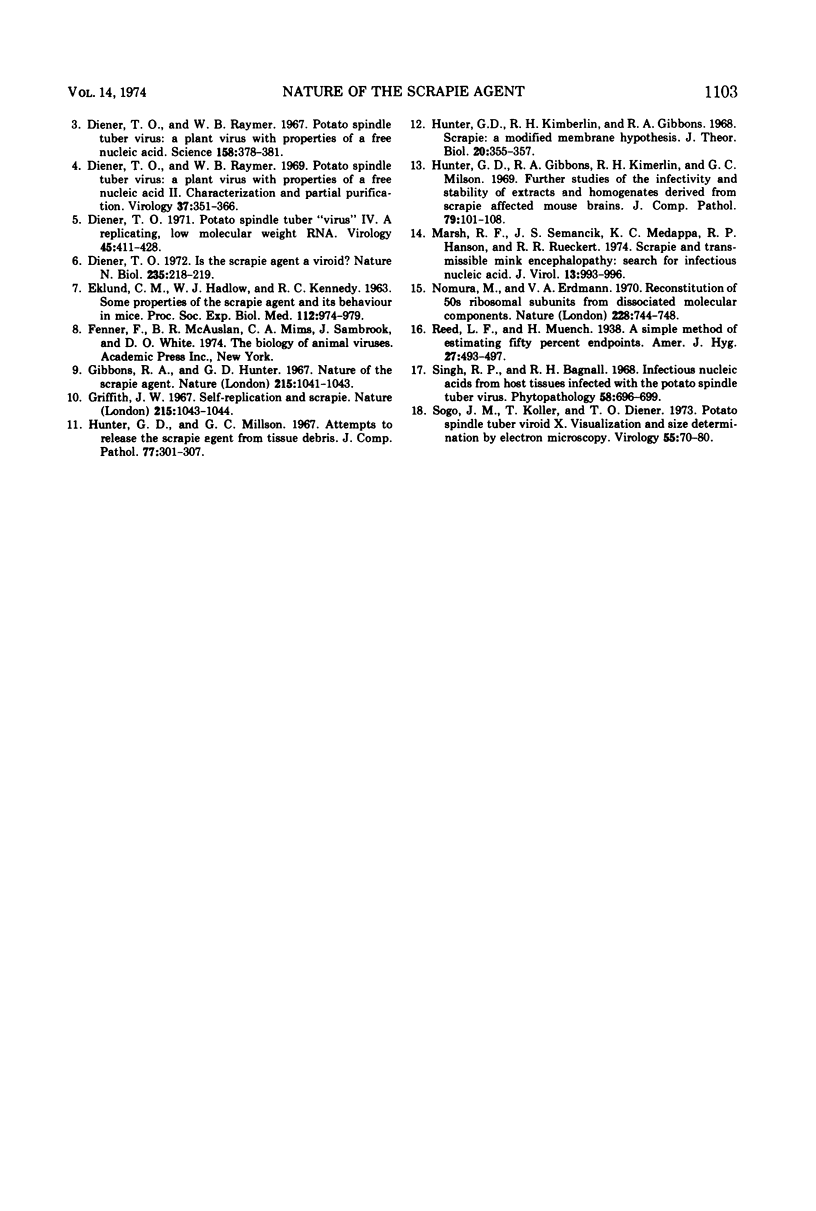Abstract
The postulated viroid nature of scrapie agent was tested. Since the agent could not be recovered after a carefully controlled phenol extraction of infected mouse brains, it is suggested that this agent is not a viroid.
Full text
PDF




Selected References
These references are in PubMed. This may not be the complete list of references from this article.
- Alper T., Haig D. A., Clarke M. C. The exceptionally small size of the scrapie agent. Biochem Biophys Res Commun. 1966 Feb 3;22(3):278–284. doi: 10.1016/0006-291x(66)90478-5. [DOI] [PubMed] [Google Scholar]
- CHANDLER R. L. Encephalopathy in mice produced by inoculation with scrapie brain material. Lancet. 1961 Jun 24;1(7191):1378–1379. doi: 10.1016/s0140-6736(61)92008-6. [DOI] [PubMed] [Google Scholar]
- Diener T. O. Is the scrapie agent a viroid? Nat New Biol. 1972 Feb 16;235(59):218–219. doi: 10.1038/newbio235218a0. [DOI] [PubMed] [Google Scholar]
- Diener T. O. Potato spindle tuber "virus". IV. A replicating, low molecular weight RNA. Virology. 1971 Aug;45(2):411–428. doi: 10.1016/0042-6822(71)90342-4. [DOI] [PubMed] [Google Scholar]
- Diener T. O., Raymer W. B. Potato spindle tuber virus: a plant virus with properties of a free nucleic acid. II. Characterization and partial purification. Virology. 1969 Mar;37(3):351–366. doi: 10.1016/0042-6822(69)90219-0. [DOI] [PubMed] [Google Scholar]
- Diener T. O., Raymer W. B. Potato spindle tuber virus: a plant virus with properties of a free nucleic acid. Science. 1967 Oct 20;158(3799):378–381. doi: 10.1126/science.158.3799.378. [DOI] [PubMed] [Google Scholar]
- Gibbons R. A., Hunter G. D. Nature of the scrapie agent. Nature. 1967 Sep 2;215(5105):1041–1043. doi: 10.1038/2151041a0. [DOI] [PubMed] [Google Scholar]
- Griffith J. S. Self-replication and scrapie. Nature. 1967 Sep 2;215(5105):1043–1044. doi: 10.1038/2151043a0. [DOI] [PubMed] [Google Scholar]
- Hunter G. D., Gibbons R. A., Kimberlin R. H., Millson G. C. Further studies of the infectivity and stability of extracts and homogenates derived from scrapie affected mouse brains. J Comp Pathol. 1969 Jan;79(1):101–108. doi: 10.1016/0021-9975(69)90033-4. [DOI] [PubMed] [Google Scholar]
- Hunter G. D., Kimberlin R. H., Gibbons R. A. Scrapie: a modified membrane hypothesis. J Theor Biol. 1968 Sep;20(3):355–357. doi: 10.1016/0022-5193(68)90135-5. [DOI] [PubMed] [Google Scholar]
- Hunter G. D., Millson G. C. Attempts to release the scrapie agent from tissue debris. J Comp Pathol. 1967 Jul;77(3):301–307. doi: 10.1016/0021-9975(67)90039-4. [DOI] [PubMed] [Google Scholar]
- Marsh R. F., Semancik J. S., Medappa K. C., Hanson R. P., Rueckert R. R. Scrapie and transmissible mink encephalopathy: search for infectious nucleic acid. J Virol. 1974 May;13(5):993–996. doi: 10.1128/jvi.13.5.993-996.1974. [DOI] [PMC free article] [PubMed] [Google Scholar]
- Nomura M., Erdmann V. A. Reconstitution of 50S ribosomal subunits from dissociated molecular components. Nature. 1970 Nov 21;228(5273):744–748. doi: 10.1038/228744a0. [DOI] [PubMed] [Google Scholar]
- Sogo J. M., Koller T., Diener T. O. Potato spindle tuber viroid. X. Visualization and size determination by electron microscopy. Virology. 1973 Sep;55(1):70–80. doi: 10.1016/s0042-6822(73)81009-8. [DOI] [PubMed] [Google Scholar]


